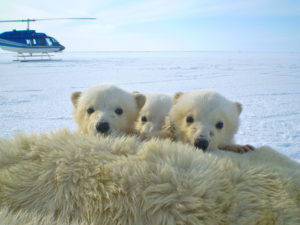The polar bear and the volcano
This article is from the Summer 2017 issue of Canadian Innovation News. You can read the full issue here.
When Environment and Climate Change Canada scientist emeritus Dr. Ian Stirling started polar bear research in western Hudson Bay in the 1980s, he never imagined that it would become the first research program in the world to demonstrate the effects of climate change on polar bears.
He and a small research team started with short two- to four-year studies. Each year, they would capture a sample of bears, tag them and collect measurements and biological samples to analyze back in the lab.
As the amount of data collected grew, the researchers started to notice that the bears they captured were getting lighter. One hypothesis was that it was due to changes in the seal population, which is the main staple of the polar bear diet. But survey data of seals in western Hudson Bay didn’t back this up.
And then, in 1992 and 1993, the body mass of polar bears increased significantly, as did the survival rate of individual bears, particularly cubs born in these years.
As it turned out, the answer to the increase in the bears’ weight and survival was found halfway around the world in the Philippines.
 (Photo: Alysa McCall, University of Alberta)
(Photo: Alysa McCall, University of Alberta)
Mount Pinatubo had erupted in June 1991 and was one of the largest volcanic eruptions in the past century. It released a vast amount of ash and other particles into the atmosphere, where the wind carried them around the globe. These particles scattered and absorbed incoming sunlight, cooling the earth, particularly in Arctic regions.
This was all the polar bears needed. A few more weeks of colder weather delayed the annual breakup of sea ice and gave them additional time out on the sea ice, hunting seals and packing on some extra pounds.
Although the benefit to polar bears from the cooling caused by Mount Pinatubo’s eruption was temporary, it provided the team’s first clue that their long-term data on polar bears could be extremely valuable in detecting large-scale ecosystem change, including the effects of climate change.
These days sea ice on Hudson Bay is breaking up in the spring 21 days earlier than it did when the research began in the early 1980s and refreezing 12 days later in the fall. Polar bears today have less time out on the ice to hunt seals and build the fat reserves they’ll need to live off while on shore. Since the research program began, nearly 4,000 individual bears have been handled. While the core objective hasn’t changed over the years, new research questions, technologies, and partnerships have allowed the program to expand.
Researchers are now studying the bears’ genetics to understand whether they might be able to adapt to climate change. They’re using hair samples to examine long-term stress levels associated with environmental change. And they’re deploying GPS-linked satellite collars to study how polar bears choose their habitat and where they go out on the sea ice.
Elsewhere in Hudson Bay, the research team is using drones to study polar bears that are switching to terrestrial food sources like seabird eggs because their primary prey (seals) is harder to come by. And of course the team is still continuing the work started all those years ago, adding to a long-term data set that is the only one of its kind in the world.
Source: Science and Technology Branch, Environment and Climate Change Canada

This article is from the Summer 2017 issue of Canadian Innovation News. You can read the full issue here.
Events For Leaders in
Science, Tech, Innovation, and Policy
Discuss and learn from those in the know at our virtual and in-person events.
See Upcoming Events
You have 0 free articles remaining.
Don't miss out - start your free trial today.
Start your FREE trial Already a member? Log in
By using this website, you agree to our use of cookies. We use cookies to provide you with a great experience and to help our website run effectively in accordance with our Privacy Policy and Terms of Service.





